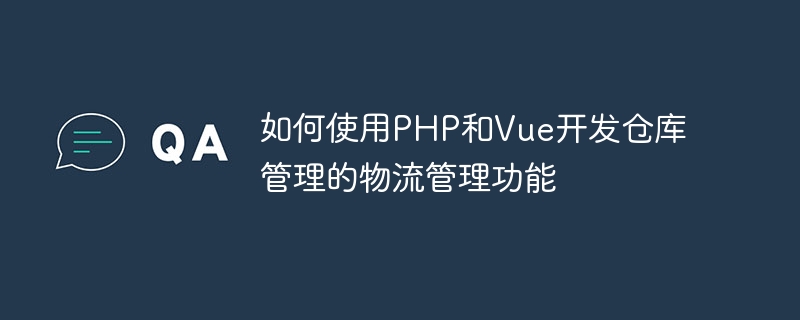如何使用PHP和Vue开发仓库管理的物流管理功能

如何使用PHP和Vue开发仓库管理的物流管理功能
随着电子商务的快速发展,仓库管理的物流管理功能变得越来越重要。在这篇文章中,我将介绍如何使用PHP和Vue来开发一个简单而实用的仓库管理系统,并提供具体的代码示例。
- 环境准备
在开始开发之前,我们需要准备一些开发环境。首先,确保你的电脑上已经安装了PHP和Vue的开发环境。你可以通过下载和安装XAMPP、WAMP或MAMP来搭建本地的PHP开发环境。同时,你也需要安装Node.js来支持Vue的开发。你可以通过在命令行中运行以下命令来检查是否已经安装了Node.js:
node -v
- 数据库设计
仓库管理系统需要一个数据库来存储物流管理的相关数据。在这个例子中,我们将需要创建一个名为"warehouse"的数据库,并创建以下两个表来存储数据:
物品表(items):用于存储所有入库的物品信息。
CREATE TABLE items ( id INT(11) AUTO_INCREMENT PRIMARY KEY, name VARCHAR(255), quantity INT(11), created_at TIMESTAMP DEFAULT CURRENT_TIMESTAMP );
物流表(shipments):用于存储所有物流信息,包括物流公司、寄件人、收件人等。
CREATE TABLE shipments ( id INT(11) AUTO_INCREMENT PRIMARY KEY, item_id INT(11), company VARCHAR(255), sender VARCHAR(255), receiver VARCHAR(255), created_at TIMESTAMP DEFAULT CURRENT_TIMESTAMP, FOREIGN KEY (item_id) REFERENCES items(id) );
- 后端开发 - PHP
接下来,我们将通过PHP来搭建后端的API接口。
首先,创建一个名为"api"的文件夹,并在其中创建一个名为"index.php"的文件。在"index.php"中,我们将创建以下几个API接口:
获取所有物品信息:
<?php
header("Content-Type: application/json");
require_once 'config.php';
$query = "SELECT * FROM items";
$result = mysqli_query($conn, $query);
$items = [];
while ($row = mysqli_fetch_assoc($result)) {
$items[] = $row;
}
echo json_encode($items);创建新物品:
<?php
header('Content-Type: application/json');
require_once 'config.php';
$name = $_POST['name'];
$quantity = $_POST['quantity'];
$query = "INSERT INTO items (name, quantity) VALUES ('$name', $quantity)";
$result = mysqli_query($conn, $query);
$response = [];
if ($result) {
$response['message'] = 'Item created successfully';
} else {
$response['message'] = 'Failed to create item';
}
echo json_encode($response);获取所有物流信息:
<?php
header("Content-Type: application/json");
require_once 'config.php';
$query = "SELECT shipments.id, items.name, shipments.company, shipments.sender, shipments.receiver, shipments.created_at
FROM shipments
INNER JOIN items
ON shipments.item_id = items.id";
$result = mysqli_query($conn, $query);
$shipments = [];
while ($row = mysqli_fetch_assoc($result)) {
$shipments[] = $row;
}
echo json_encode($shipments);创建新物流信息:
<?php
header('Content-Type: application/json');
require_once 'config.php';
$item_id = $_POST['item_id'];
$company = $_POST['company'];
$sender = $_POST['sender'];
$receiver = $_POST['receiver'];
$query = "INSERT INTO shipments (item_id, company, sender, receiver) VALUES ($item_id, '$company', '$sender', '$receiver')";
$result = mysqli_query($conn, $query);
$response = [];
if ($result) {
$response['message'] = 'Shipment created successfully';
} else {
$response['message'] = 'Failed to create shipment';
}
echo json_encode($response);在"api"文件夹中还需要创建一个名为"config.php"的文件,该文件用来配置数据库连接信息:
<?php
$conn = mysqli_connect('localhost', 'root', '', 'warehouse');
if (!$conn) {
die("Connection failed: " . mysqli_connect_error());
}- 前端开发 - Vue
现在,我们将使用Vue来开发前端界面。
在项目的根目录下创建一个名为"frontend"的文件夹,并通过命令行进入该文件夹。
首先,安装Vue CLI。在命令行中运行以下命令:
npm install -g @vue/cli
创建一个新的Vue项目。在命令行中运行以下命令,并根据提示进行配置:
vue create warehouse-management
进入新创建的Vue项目的目录。在命令行中运行以下命令:
cd warehouse-management
安装所需的依赖。在命令行中运行以下命令:
npm install
在"src"文件夹中创建一个名为"components"的文件夹,并在其中创建以下几个组件:
Item列表组件(ItemList.vue):
<template>
<div>
<h2 id="物品列表">物品列表</h2>
<table>
<thead>
<tr>
<th>物品名称</th>
<th>数量</th>
<th>操作</th>
</tr>
</thead>
<tbody>
<tr v-for="item in items" :key="item.id">
<td>{{ item.name }}</td>
<td>{{ item.quantity }}</td>
<td>
<button @click="deleteItem(item.id)">删除</button>
</td>
</tr>
</tbody>
</table>
<h3 id="添加新物品">添加新物品</h3>
<input type="text" v-model="newItemName" placeholder="物品名称">
<input type="number" v-model="newItemQuantity" placeholder="数量">
<button @click="createItem">添加</button>
</div>
</template>
<script>
export default {
data() {
return {
items: [],
newItemName: '',
newItemQuantity: 0
};
},
mounted() {
this.getItems();
},
methods: {
getItems() {
axios.get('/api/get_items.php').then(response => {
this.items = response.data;
});
},
createItem() {
axios.post('/api/create_item.php', {
name: this.newItemName,
quantity: this.newItemQuantity
}).then(response => {
this.getItems();
this.newItemName = '';
this.newItemQuantity = 0;
});
},
deleteItem(id) {
axios.post('/api/delete_item.php', {
id: id
}).then(response => {
this.getItems();
});
}
}
};
</script>Shipment列表组件(ShipmentList.vue):
<template>
<div>
<h2 id="物流列表">物流列表</h2>
<table>
<thead>
<tr>
<th>物品名称</th>
<th>物流公司</th>
<th>寄件人</th>
<th>收件人</th>
<th>创建时间</th>
</tr>
</thead>
<tbody>
<tr v-for="shipment in shipments" :key="shipment.id">
<td>{{ shipment.name }}</td>
<td>{{ shipment.company }}</td>
<td>{{ shipment.sender }}</td>
<td>{{ shipment.receiver }}</td>
<td>{{ shipment.created_at }}</td>
</tr>
</tbody>
</table>
<h3 id="添加新物流">添加新物流</h3>
<select v-model="selectedItem">
<option v-for="item in items" :value="item.id">{{ item.name }}</option>
</select>
<input type="text" v-model="newShipmentCompany" placeholder="物流公司">
<input type="text" v-model="newShipmentSender" placeholder="寄件人">
<input type="text" v-model="newShipmentReceiver" placeholder="收件人">
<button @click="createShipment">添加</button>
</div>
</template>
<script>
export default {
data() {
return {
items: [],
selectedItem: '',
shipments: [],
newShipmentCompany: '',
newShipmentSender: '',
newShipmentReceiver: ''
};
},
mounted() {
this.getItems();
this.getShipments();
},
methods: {
getItems() {
axios.get('/api/get_items.php').then(response => {
this.items = response.data;
});
},
getShipments() {
axios.get('/api/get_shipments.php').then(response => {
this.shipments = response.data;
});
},
createShipment() {
axios.post('/api/create_shipment.php', {
item_id: this.selectedItem,
company: this.newShipmentCompany,
sender: this.newShipmentSender,
receiver: this.newShipmentReceiver
}).then(response => {
this.getShipments();
this.newShipmentCompany = '';
this.newShipmentSender = '';
this.newShipmentReceiver = '';
});
}
}
};
</script>在"src"文件夹中打开"App.vue"文件,将以下代码添加到文件的相应位置:
<template>
<div id="app">
<item-list></item-list>
<shipment-list></shipment-list>
</div>
</template>
<script>
import ItemList from './components/ItemList.vue';
import ShipmentList from './components/ShipmentList.vue';
export default {
components: {
ItemList,
ShipmentList
}
};
</script>至此,我们已经完成了使用PHP和Vue开发仓库管理的物流管理功能的示例代码。你可以通过运行"npm run serve"命令来开启前端开发服务器,在浏览器中访问"http://localhost:8080"来查看项目效果。同时,你也需要通过运行PHP开发服务器来让API接口生效。
希望以上示例能够帮助你了解如何使用PHP和Vue来开发仓库管理的物流管理功能。当然,这只是一个简单的示例,你可以根据实际需求进行功能的扩展和优化。祝你开发顺利!
以上是如何使用PHP和Vue开发仓库管理的物流管理功能的详细内容。更多信息请关注PHP中文网其他相关文章!

热AI工具

Undresser.AI Undress
人工智能驱动的应用程序,用于创建逼真的裸体照片

AI Clothes Remover
用于从照片中去除衣服的在线人工智能工具。

Undress AI Tool
免费脱衣服图片

Clothoff.io
AI脱衣机

AI Hentai Generator
免费生成ai无尽的。

热门文章

热工具

记事本++7.3.1
好用且免费的代码编辑器

SublimeText3汉化版
中文版,非常好用

禅工作室 13.0.1
功能强大的PHP集成开发环境

Dreamweaver CS6
视觉化网页开发工具

SublimeText3 Mac版
神级代码编辑软件(SublimeText3)

热门话题
 您如何防止班级被扩展或方法在PHP中被覆盖? (最终关键字)
Apr 08, 2025 am 12:03 AM
您如何防止班级被扩展或方法在PHP中被覆盖? (最终关键字)
Apr 08, 2025 am 12:03 AM
在PHP中,final关键字用于防止类被继承和方法被重写。1)标记类为final时,该类不能被继承。2)标记方法为final时,该方法不能被子类重写。使用final关键字可以确保代码的稳定性和安全性。
 vue.js怎么引用js文件
Apr 07, 2025 pm 11:27 PM
vue.js怎么引用js文件
Apr 07, 2025 pm 11:27 PM
在 Vue.js 中引用 JS 文件的方法有三种:直接使用 <script> 标签指定路径;利用 mounted() 生命周期钩子动态导入;通过 Vuex 状态管理库进行导入。
 vue中的watch怎么用
Apr 07, 2025 pm 11:36 PM
vue中的watch怎么用
Apr 07, 2025 pm 11:36 PM
Vue.js 中的 watch 选项允许开发者监听特定数据的变化。当数据发生变化时,watch 会触发一个回调函数,用于执行更新视图或其他任务。其配置选项包括 immediate,用于指定是否立即执行回调,以及 deep,用于指定是否递归监听对象或数组的更改。
 vue怎么给按钮添加函数
Apr 08, 2025 am 08:51 AM
vue怎么给按钮添加函数
Apr 08, 2025 am 08:51 AM
可以通过以下步骤为 Vue 按钮添加函数:将 HTML 模板中的按钮绑定到一个方法。在 Vue 实例中定义该方法并编写函数逻辑。
 vue中怎么用bootstrap
Apr 07, 2025 pm 11:33 PM
vue中怎么用bootstrap
Apr 07, 2025 pm 11:33 PM
在 Vue.js 中使用 Bootstrap 分为五个步骤:安装 Bootstrap。在 main.js 中导入 Bootstrap。直接在模板中使用 Bootstrap 组件。可选:自定义样式。可选:使用插件。
 vue返回上一页的方法
Apr 07, 2025 pm 11:30 PM
vue返回上一页的方法
Apr 07, 2025 pm 11:30 PM
Vue.js 返回上一页有四种方法:$router.go(-1)$router.back()使用 <router-link to="/"> 组件window.history.back(),方法选择取决于场景。
 vue懒加载什么意思
Apr 07, 2025 pm 11:54 PM
vue懒加载什么意思
Apr 07, 2025 pm 11:54 PM
在 Vue.js 中,懒加载允许根据需要动态加载组件或资源,从而减少初始页面加载时间并提高性能。具体实现方法包括使用 <keep-alive> 和 <component is> 组件。需要注意的是,懒加载可能会导致 FOUC(闪屏)问题,并且应该仅对需要懒加载的组件使用,以避免不必要的性能开销。
 vue遍历怎么用
Apr 07, 2025 pm 11:48 PM
vue遍历怎么用
Apr 07, 2025 pm 11:48 PM
Vue.js 遍历数组和对象有三种常见方法:v-for 指令用于遍历每个元素并渲染模板;v-bind 指令可与 v-for 一起使用,为每个元素动态设置属性值;.map 方法可将数组元素转换为新数组。






